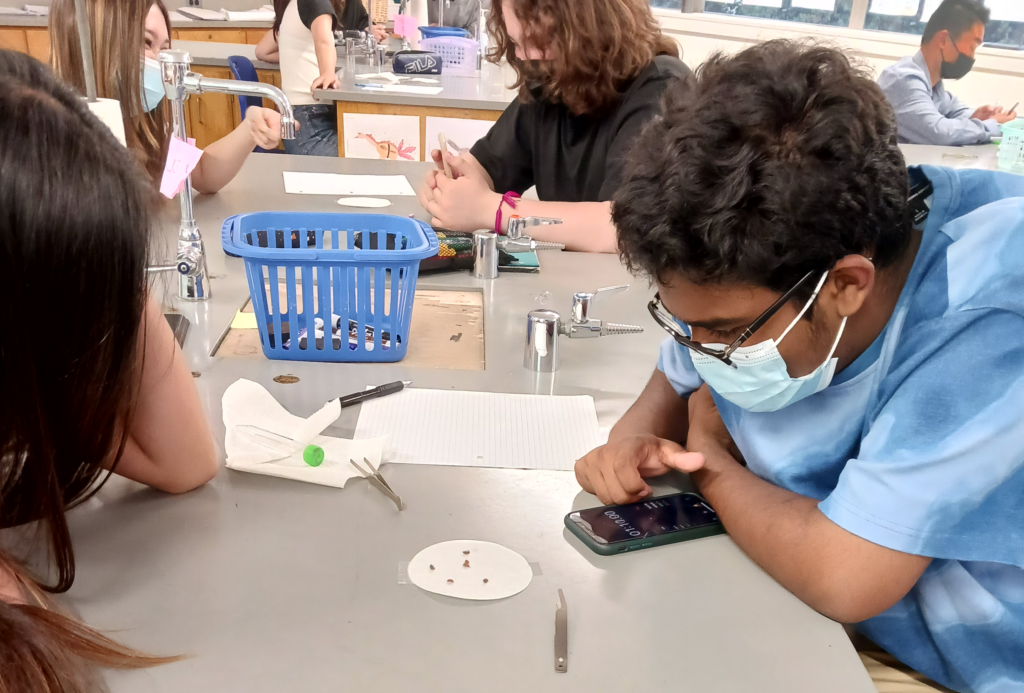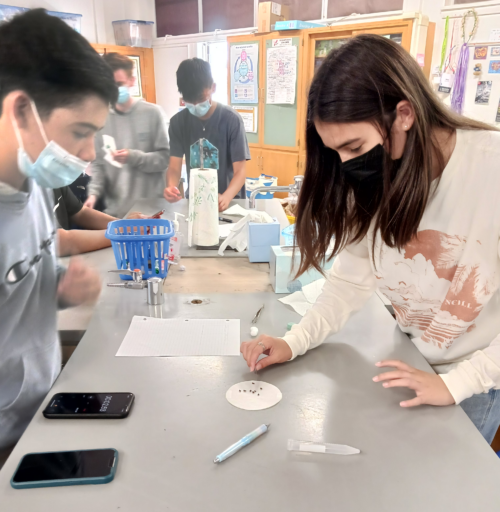Investigating insects in a warming world
Instructional Unit on Adaptation and Evolution: Phenotypic/Genotypic Response to Climate Change in Lady Beetles
Overview
Read about the corresponding research of Elizabeth Dahlhoff and Nathan Rank
The Beetle Project uses insects as a model system to illustrate the biological impacts of climate change, with the goal of engaging students with a range of hands-on and minds-on activities that increase their understanding of how science works, evolutionary processes, and the impacts of climate change. Module components can be combined in different ways and include:
- a set of whole-organism/behavior lab activities using lady beetles (also known as ladybugs or ladybird beetles)
- a paper-and-pencil Data Nugget data analysis activity
- reading with discussion questions that highlights scientific research paralleling student lab activities
- extension lessons drawn from freely available materials produced by the University of Florida
- extension lessons for AP Biology.
Suggestions are included to adapt materials for students who need more or less scaffolding, and for classrooms with greater or lesser access to lab resources.
Instructional level: high school biology, AP Biology, college-level introductory biology

Curriculum overview
Lesson 1 investigates the question, “How are organisms responding to rapid ecosystem change?”. Students will understand that climate change involves not only global warming but also increased weather extremes and seasonal shifts. They will learn how certain kinds of insects survive the winter. Optional additions and extensions teach students to distinguish between genotypic and phenotypic variation, explain the concept of phenotypic plasticity, and identify particular species that may be better suited to survive extreme climate events.
In Lesson 2, students are introduced to lady beetles as a model organism. Students use their learning to explore how lady beetles might respond to environmental temperature change.
Lesson 3 allows students to test their exploratory ideas. Different lab options include:
- A guided inquiry lab, in which students measure the Chill Coma Recovery Time of beetles from a known geographical location and compare it to beetles from other locations.
- An open inquiry lab, in which students design and conduct their own experiments to measure Chill Coma Recovery time as a function of self-identified variables.
- A dry lab/data analysis option; which may be used if either inquiry lab is not feasible, or as an extension.
The laboratory experiment in brief: A useful, quantifiable trait in lady beetles and their relatives is their natural ability to enter Chill Coma. Chill coma is a reversible total paralysis; emergence from chill coma can be timed. This measurable parameter is known as Chill Coma Recovery Time (CCRT). CCRT may show both geographic variation among lady beetle populations, and temporal variation during different seasons. Students place groups of live lady beetles into culture tubes and immerse the tubes in crushed ice. After 24 hours, students time the emergence of their beetles from Chill Coma. Class results are compiled and compared to existing outcomes.
Pacing guide (based on 1-hour lessons)

Optional activities suggested below can extend the sequence for up to an additional four lesson periods.
Suggested prerequisite knowledge:
- Basic understanding of the causes of global climate change
- Basic graphing and foundational statistics (histograms, mean, standard error; middle-school level of understanding or better)
LESSON 1 (one 1-hour lesson period)
- Short film + discussion
- Learn about “Whiplash Weather”
- Student research: “How do insects survive the winter?”
LESSON 2 (one 1-hour lesson period)
- Introduction to lady beetles
- Student design of experiment
LESSON 3 (one or two+ 1-hour lesson periods; note that at least two lesson periods are required in order to engage students with the live lady beetle experiment)
- Data Nugget data analysis activity only (one lesson period) OR guided inquiry lab with live organisms (two lesson periods) OR open inquiry lab with live organisms two+ lesson periods)
Optional elaboration/extension lessons (one to four 1-hour lesson periods, suggested placement: during or after Lesson 1)
- Introduction to phenotypic plasticity
- Student activity: “Winners and Losers”
AP-level lesson sequence with different pacing is available in the first tab below.
Let's connect!
Educators who have implemented these lab activities in their classroom are invited to connect their students directly with an evolutionary biologist from our team. Just fill out this feedback survey, and we'll arrange a video chat between your classroom and a UC Berkeley scientist. You can also submit photos of experimental set-ups your students have designed, as well as their results. We're also curious to hear how you implemented these labs and about your students' results. Email us at beetleproject@LISTS.berkeley.edu.
Need help? Email us at beetleproject@LISTS.berkeley.edu.
Most materials are downloads in .docx format.
- High school lab unit (including all lessons and handouts below)
- Unit overview, including suggestions for curriculum placement and pacing
- Lesson 1 (one hour): How are organisms responding to rapid ecosystem change?
- Student Handout 1: “Whiplash Weather” reading guide
- Student Handout 2: How do insects survive the winter?
- Lesson 2 (one hour): How might lady beetles respond to temperature change?
- Student handout 1: Lady beetles and temperature change
- Lesson 3 (one to two hours): How can lady beetles’ response to temperature change be tested?
- Teacher guide, day 1: Preparation and day 1 of Beetle Lab
- Teacher guide, day 2: Procedures for measuring CCRT
- Student handout 1: Determining CCRT variability in different lady beetle populations
- Supplemental lesson/student handout: Mean, standard deviation, and standard error
- Sample lab report template
To make a more direct connection to evolution, adaptation, and phenotypic plasticity, use the following extension lessons. They should be placed after basic Lesson 1 (How are organisms responding to rapid ecosystem change?) and before basic Lesson 2 (How might lady beetles respond to temperature change?)
- Introduction to phenotypic plasticity
- Student activity: “Winners and Losers” (Coming soon)
Additional media:
- Case study on willow leaf beetle research and student reading guide
- Video introduction to willow leaf beetle habitat and research: the first 11 minutes of the video provide background, and coverage of willow leaf beetle research begins around minute 31
- HS-LS2-2. Use mathematical representations to support and revise explanations based on evidence about factors affecting biodiversity and populations in ecosystems of different scales.
- HS-LS2-6. Evaluate the claims, evidence, and reasoning that the complex interactions in ecosystems maintain relatively consistent numbers and types of organisms in stable conditions, but changing conditions may result in a new ecosystem.
- HS-LS3-1. Ask questions to clarify relationships about the role of DNA and chromosomes in coding the instructions for characteristic traits passed from parents to offspring.
- HS-LS3-2. Make and defend a claim based on evidence that inheritable genetic variations may result from: (1) new genetic combinations through meiosis, (2) viable errors occurring during replication, and/or (3) mutations caused by environmental factors. [Clarification Statement: Emphasis is on using data to support arguments for the way variation occurs.]
- HS-LS3-3. Apply concepts of statistics and probability to explain the variation and distribution of expressed traits in a population.
- HS-LS4-2. Construct an explanation based on evidence that the process of evolution primarily results from four factors: (1) the potential for a species to increase in number, (2) the heritable genetic variation of individuals in a species due to mutation and sexual reproduction, (3) competition for limited resources, and (4) the proliferation of those organisms that are better able to survive and reproduce in the environment.
- HS-LS4-3. Apply concepts of statistics and probability to support explanations that organisms with an advantageous heritable trait tend to increase in proportion to organisms lacking this trait.
- HS-LS4-4. Construct an explanation based on evidence for how natural selection leads to adaptation of populations.
- HS-LS4-5. Evaluate the evidence supporting claims that changes in environmental conditions may result in: (1) increases in the number of individuals of some species, (2) the emergence of new species over time, and (3) the extinction of other species.
For AP Biology Learning Objectives, Essential Knowledge, and Science Practices, see the AP Biology Extension Overview.
This material is supported by the National Science Foundation under Grant Number IOS-1558159 to Caroline Williams, Nathan Rank, Elizabeth Dahlhoff, and Jonathon Stillman. Any opinions, findings, and conclusions or recommendations expressed in this material are those of the author(s) and do not necessarily reflect the views of the National Science Foundation. Nicoline Chambers’ teacher research experience was supported by the BEACON Center for the Study of Evolution (National Science Foundation grant number: DBI - 1446483), the Society for the Study of Evolution, and Wiley Publishers.
- Author of standard lessons: Nikki Chambers
- Author of AP Biology materials: Aaron Mathieu
- Author of reading guide: Ann Cortina
- Developing and piloting lab activities: Caroline Williams, Ana Lyons, Andre Szejner Sigal, Nikki Chambers, Aaron Mathieu, Ann Cortina, Kevin Roberts, Emma Isella
- Project coordination: Caroline Williams
- Editing and collating materials: Anna Thanukos
- Web production: Trish Roque
- Illustration: Helina Chin
